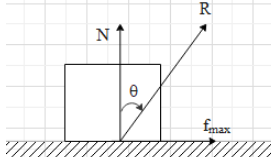
Define angle of friction.
Answer
555k+ views
Hint:Friction is a resistive force that comes into play when there is a relative motion between the surfaces of two bodies in contact. Before defining the angle of friction, understand what static friction is.
Complete answer:
Let us first understand what is meant by friction. Friction is a resistive force that comes into play when there is a relative motion between the surfaces of two bodies in contact. The friction occurs due to the molecular interaction at the surfaces of the two bodies. It is also due to the roughness of the surfaces.
Now, consider a cubical block on a rough horizontal plane. If we try to move the block by applying a force on it, we will observe that for some value of force less than a certain value the block does not move. This is due to the static friction between the block and the plane.
Static friction is variable frictional force. It tends to keep the block at rest by exerting a force on the block of magnitude equal to the applied force but the direction is opposite to that of the applied force. However, this frictional force has a limit. The maximum value of static friction is equal to ${{f}_{\max }}=\mu N$, where $\mu $ is the coefficient of static friction and N is the normal reaction on the block.
Now, angle of friction is defined as the angle that the resultant of the normal reaction force (N) on the block and the maximum static friction makes with the normal reaction force.This can be understood by the figure given below.

Here, $R$ is the resultant force and $\theta $ is the angle of friction.
Note:Static friction is not a constant force. Its value changes with the change in the applied force. But it has a maximum value. For friction, both the surfaces must be contacted. If there is a relative motion, the force acts on both the surfaces. The static friction acts until the block is at rest. Once the block comes into motion, the friction acting on the system is called kinetic friction.
Complete answer:
Let us first understand what is meant by friction. Friction is a resistive force that comes into play when there is a relative motion between the surfaces of two bodies in contact. The friction occurs due to the molecular interaction at the surfaces of the two bodies. It is also due to the roughness of the surfaces.
Now, consider a cubical block on a rough horizontal plane. If we try to move the block by applying a force on it, we will observe that for some value of force less than a certain value the block does not move. This is due to the static friction between the block and the plane.
Static friction is variable frictional force. It tends to keep the block at rest by exerting a force on the block of magnitude equal to the applied force but the direction is opposite to that of the applied force. However, this frictional force has a limit. The maximum value of static friction is equal to ${{f}_{\max }}=\mu N$, where $\mu $ is the coefficient of static friction and N is the normal reaction on the block.
Now, angle of friction is defined as the angle that the resultant of the normal reaction force (N) on the block and the maximum static friction makes with the normal reaction force.This can be understood by the figure given below.

Here, $R$ is the resultant force and $\theta $ is the angle of friction.
Note:Static friction is not a constant force. Its value changes with the change in the applied force. But it has a maximum value. For friction, both the surfaces must be contacted. If there is a relative motion, the force acts on both the surfaces. The static friction acts until the block is at rest. Once the block comes into motion, the friction acting on the system is called kinetic friction.
Recently Updated Pages
A man running at a speed 5 ms is viewed in the side class 12 physics CBSE

The number of solutions in x in 02pi for which sqrt class 12 maths CBSE

State and explain Hardy Weinbergs Principle class 12 biology CBSE

Write any two methods of preparation of phenol Give class 12 chemistry CBSE

Which of the following statements is wrong a Amnion class 12 biology CBSE

Differentiate between action potential and resting class 12 biology CBSE

Trending doubts
What are the major means of transport Explain each class 12 social science CBSE

Which are the Top 10 Largest Countries of the World?

Draw a labelled sketch of the human eye class 12 physics CBSE

How much time does it take to bleed after eating p class 12 biology CBSE

Explain sex determination in humans with line diag class 12 biology CBSE

Explain sex determination in humans with the help of class 12 biology CBSE




